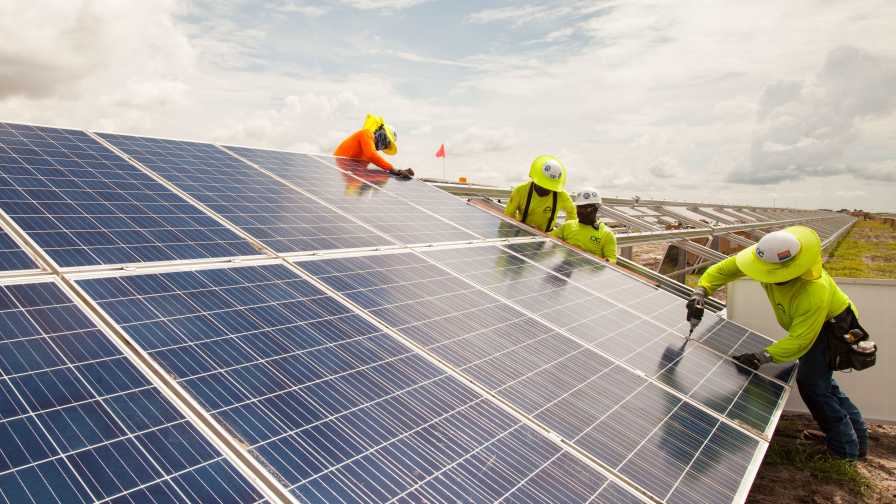Are There Bright Futures in Solar Farming?

Babcock Ranch near Ft. Myers, FL, will be entirely powered by solar energy. Its solar field spans acres.
Photo courtesy of Florida Power & Light
If you are a landowner with a sizable tract in a rural area near a main power transmission line, you might be in a good spot to consider opportunities as Florida’s utility companies continue to expand their solar power capacity.
In 2009, Florida Power & Light (FPL) constructed the FPL DeSoto Next Generation Solar Energy Center. At the time, the 25-megawatt plant was the largest of its kind in the state. FPL has said it intends to build up to 16 new solar panel plants by the end of this year. This will require the installation of 2.5 million solar panels across the state. Duke Energy and Tampa Electric also are pursuing aggressive solar energy plans.
Many believed the defeat of the 2016 Florida Amendment No. 1 would stifle solar expansion, but this has not slowed power companies accelerated interest in developing new sites.
According to Michael Minton, an attorney with Dean Mead law firm, this presents a revenue opportunity for landowners with the right tract of land. Existing farmland has proven to be attractive to the power companies because they tend to have less wetland and endangered species obstacles and isolation to help avoid not in my back yard conflicts.
“There are numerous alternative and renewable sources of energy, but the one that is most promising in Florida is solar,” Minton says. “We have plenty of sunny days and don’t have a lot of obstructions to the sun. We do a lot of work for agribusiness and our clients have properties that are attractive to the power companies, so we got involved in this more from a demand seeking a supply end of things.”
Location, Location, Location
Minton says as a rule of thumb, the major power companies are looking for 4 to 5 acres of land for every megawatt of solar energy production. They are usually interested in creating 75-megawatt solar fields.
“Generally, the developers of the solar production facilities are looking for 300 to 400 acres of usable land,” he says. “Sometimes that will require up to 500 acres because you have to account for things like wetlands, which they have to avoid. And, the property will need to be near grid transmission lines with the capacity to move the energy.
“Many of our larger agricultural concerns like cattle and citrus already have impacted the land and are ideally situated to meet those needs. If you consider citrus where greening has impacted so many groves, it could represent an opportunity.”
Minton adds that if a landowner holds property ideal for solar fields, it is likely he or she has already been approached by a realtor trying to tie up the property.
“Landowners need to be careful not to get tied up in a listing agreement that is not in their best interest and be sure they are dealing with reputable and knowledgable people,” he says.
To get a good idea how well a property is suited for solar, an engineering expert can analyze the site and its proximity to transmission lines. If a property passes the test, a power purchase agreement (PPA) can be entered into between the power company and ultimate developer of the solar power field.
“The PPA is most important,” Minton says. “Once you have it, the developers are more interested in buying the property or leasing the land. And, a PPA is a bankable contract and most any sophisticated financial institutions will lend money on a project based on the amount of energy capacity and price determined by the PPA.
“We are talking about a pretty significant investment for these fields. The cost to develop a 75-megawatt field on about 400 acres is around $100 million.”
With a PPA and local land use and zoning issues in hand, Minton says growers have something they can market for sale or long-term lease. He says his firm has managed transactions from $7,500 per acre up to multiples of this amount per acre for better situated properties.
“We have negotiated leases for as long as 30 years at rental rates far in excess of what you might expect for vegetable and row crop land rents,” he says. “For growers, it [a lease] can be a way to take the peaks and valleys out of their revenue stream. They will have a steady check coming in for the life of the lease if they execute the lease correctly.”

Power companies are seeking properties to construct new solar panel fields.
Photo courtesy of Florida Power & Light
Act Now
While energy policy in recent years has encouraged the development of domestic fossil fuel sources, there are still several tax incentives in place to encourage the development of renewable energy sources. As of this posting, the Tax Cut and Jobs Act appeared to be closing in on approval, which could impact the future of solar incentives.
“We were a little concerned about the proposed tax reform legislation, because the current administration is much more concerned with the old carbon-based energies,” Minton says. “But, it appears we have a good news/bad news situation. The good news is the legislation does not accelerate the repeal of tax incentives and credits for solar installations. The bad news is they didn’t extend those incentives into future years like previous congresses have.”
That means there is about a three-year window in which the current incentives to promote the use of solar energy will be in place. Minton adds there always will be opportunities for future incentive programs, but solar is hot, so if you have a desirable property, the time to act is now.










